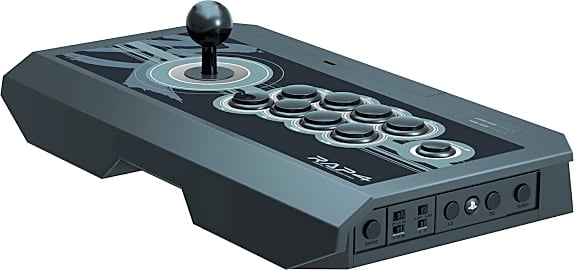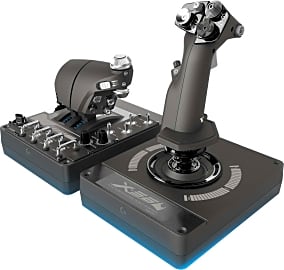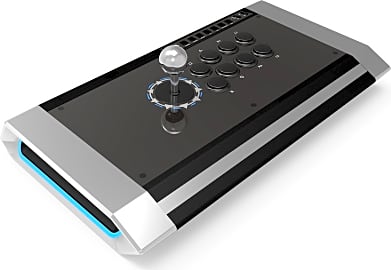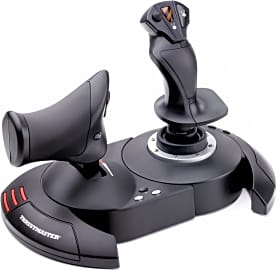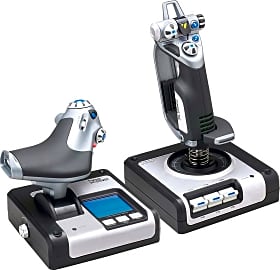The 10 Best PC Joysticks

This wiki has been updated 42 times since it was first published in July of 2015. PC joysticks can take your gaming experience to the next level. They provide a realistic feel that helps to recreate the sensation of living on the edge as a fighter pilot, battling evil forces in far-flung galaxies, or pushing yourself to the limit as a warrior. Decide which of the available styles is best for your gameplay, and you'll wonder how you ever survived with just a mouse and keyboard. When users buy our independently chosen editorial recommendations, we may earn commissions to help fund the Wiki.
Editor's Notes
November 20, 2020:
For this update, we've removed the Mad Catz V.1 and VKB Sim Gladiator due to availability issues and replaced the Mayflash F300 with the Mayflash Universal F500. We've also made a few small updates to the listing for the ThrustMaster T16000M and revised the order of our ranking.
We've updated our list with a total of three new "arcade-style fighting stick" models, the Qanba Drone, the Hori Real Arcade Pro 4, and the Mayflash Universal F500. These all feature the traditional stick and button layouts popularized by the fighting game genre and are ideal for that type of gameplay. However, they can be used for almost any game you want to play if you map the controls to your choice of play style. The Qanba Drone is a cost-effective solution that offers many of the features of more expensive models. It's a lightweight portable option, and its small size makes it a great choice for those who like to travel and still want to game. The Mayflash Universal F500 is a worthy improvement over the F300. It provides vibration feedback and offers many options for personalization. Finally, the Hori Real Arcade Pro 4 is a highly-rated piece of equipment that comes in several different color-schemes. It also stands out as one of the few options to have a touchpad, which can assist with mouse-related movements and other inputs requiring precise control.
December 16, 2019:
While I typically avoid oversaturating a list with too many models from one brand, the ThrustMaster is really the exception to this rule here. ThrustMaster continues to release sophisticated models, like the ThrustMaster T16000M, and years after its release, the ThrustMaster HOTAS Warthog is still a top-of-the-line option that continues to deliver on realism (as a replica of the joystick from the A-10C Thunderbolt II fighter jet), durability and sensitivity.
One of the newer models I’ve added is the Logitech G X56 HOTAS, which is basically a more sophisticated version of the recently removed Saitek PS28 X52 - the X56 uses a 4-spring centering mechanism (vs. a single spring for the PS28 X52), and adds more axes of movement and customization options. I also replaced the Saitek PS28 X52 with a newer version – the Logitech G X52.
The G X56 HOTAS is actually more feature-rich than the ThrustMaster HOTAS Warthog, but the latter really takes the cake on design simplicity and ease of use - it isn’t always about the number of configuration options available. I removed the CH Products Combatstick which is still a good product that really delivers on value for money, but whose software was struggling with Windows 10 compatibility issues. CH said that they would no longer update or support software-related issues. I also removed the overpriced and simplistic Microsoft Sidewinder 2, which has, unfortunately in my opinion, not aged as well as the CH Products Combatstick.
Dynamic And Interactive
A joystick is an input device that makes it possible for a user to control either a character or object within a computer program.
Whether you play video games or you're testing out a fancy flight simulator on your computer, something gets lost in translation when you're forced to use your machine's keyboard to control and interact with what you see on the screen. A joystick is not only easier and more comfortable to control than a keyboard, but the device delivers a much higher degree of precision and sensitivity to your in-game action, which is something you won't experience from an ordinary keystroke.
A joystick is an input device that makes it possible for a user to control either a character or object within a computer program. The main component of the device is a center stick that pivots on top of a base and reports both its angle and direction to whatever it controls. The device translates the individual movements of a user's hand into a digital format that a piece of software can interpret as a resulting action. The joystick resembles a control device you might find on older arcade style games, but with the inclusion of extra buttons for additional functionality and an ergonomically-designed profile that improves overall user comfort.
Two main types of joysticks include analog and digital. The digital joystick makes use of an electronic switch comprised of a printed circuit board and wires connected to several contact terminals, all of which are located underneath the joystick's base. Ordinary wires also extend from each contact terminal to the PC itself. The printed wires form a simple electric circuit made up of several smaller circuits. These smaller circuits ultimately carry electricity from one contact point to another. When the digital joystick is centered, all but one of these smaller circuits are broken. Each small circuit is also covered with its own dedicated plastic button and small metal disc. When the joystick moves to the left, for example, the corresponding plastic button and disc associated with this directional input will press against the joystick's main circuit board, thereby closing the small circuit, allowing electricity to flow through the corresponding printed and ordinary wires, and making the character or object on the screen turn left in the game or simulator. A similar order of operations will occur when you push one of the joystick's function buttons.
Analog joysticks detect the full range of motion, making them well-suited for use in flight simulators. This improved sensitivity to movement is accomplished through the use of potentiometers designed to measure the joystick's pivoted shaft position along both X and Y axes. The X-axis represents side-to-side (horizontal) motion, while the Y-axis represents up and down (or forward and reverse) movement. When the stick moves along either its X or Y axis, the corresponding potentiometer will either increase or decrease the resistance of the electrical current according to the stick's position along the shaft, thereby converting this position to an electrical signal that travels to the joystick port on the computer. Finally, several built-in springs in the device will also center the stick when you release it.
Getting The Most Out Of Your Experience
There are several considerations to keep in mind when investing in a PC joystick, such as the device's overall durability. Look for an option with a heavy, sturdy base and molded handgrips for additional comfort. If you're interested in having the most realistic gaming experience possible, then a detachable joystick is a bonus, as it will allow you to mount the device on other objects like a gaming chair.
Think about the joystick's ability to perform 3D rotational action with the presence of a Z axis control scheme.
Multiple programmable action buttons are quite helpful, as they minimize your reliance on a conventional keyboard, which could otherwise detract from an authentic flight simulator experience. Consider joysticks with separate throttle controls and adjustable resistance for improved realism. Think about the joystick's ability to perform 3D rotational action with the presence of a Z axis control scheme. By allowing the rotation of the stalk clockwise or in reverse, 3D control space will mimic the operation of a real aircraft’s rudders.
Many joysticks also feature ambidextrous designs with removable components for accommodating both left- and right-handed users. This will come in particularly handy if you share the stick with friends and family.
If total in-game immersion is what you're after, then look for a device with an integrated hat switch, so you can always have a look at the world around you from different angles on the screen.
From Joystick Practicality To Gaming
One of the first electrical two-axis joystick was invented as a possible support for the development of radio-controlled aircraft, in 1926 by C. B. Mirick at the United States Naval Research Laboratory. The Germans developed a similar device in 1944 to control and steer bomber aircraft missiles toward their targets. By the 1960s, NASA employed the joystick as a control device for the Apollo missions.
By the year 1969, the Sega video game company released its first electronic joystick equipped with a fire button for its Missile shooter simulation game.
The first joysticks for video games were invented in 1967 by Ralph H. Baer, and were capable of controlling both the horizontal and vertical positions of a spot on a television screen. By the year 1969, the Sega video game company released its first electronic joystick equipped with a fire button for its Missile shooter simulation game. One of the first digital joystick controllers followed in 1977 as a companion device for the Atari 2600 gaming system.
The 1985 release of Sega's third-person rail shooter game Space Harrier saw the development of the first true analog joystick, which could register a player's movements in any direction as well as the degree of push.
Since the 1990s, the analog joystick has become the standard design for the majority of video game console controllers due to its convenient thumb control, as well as its use of potentiometers for determining the exact location of the joystick along an axis.


